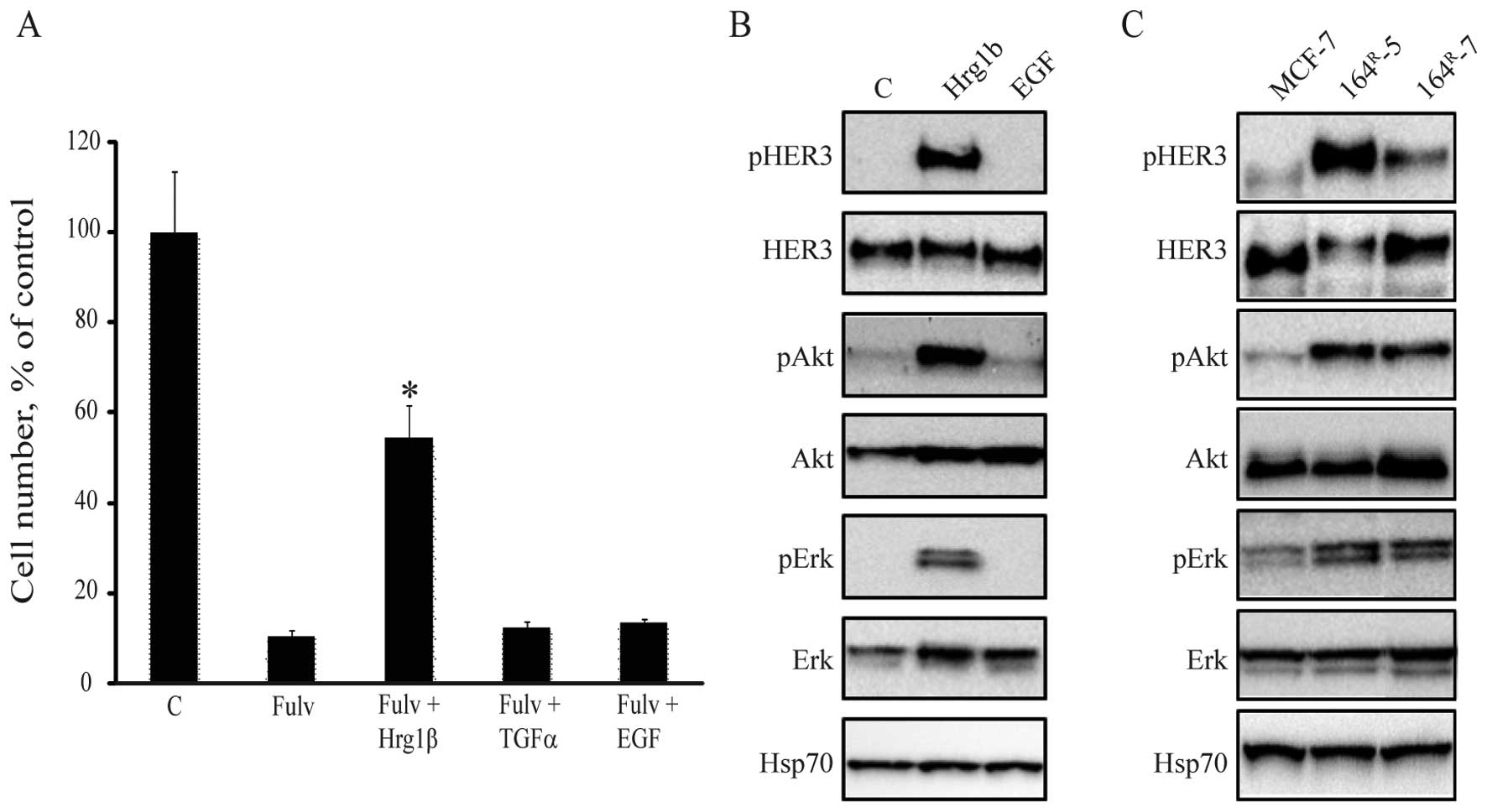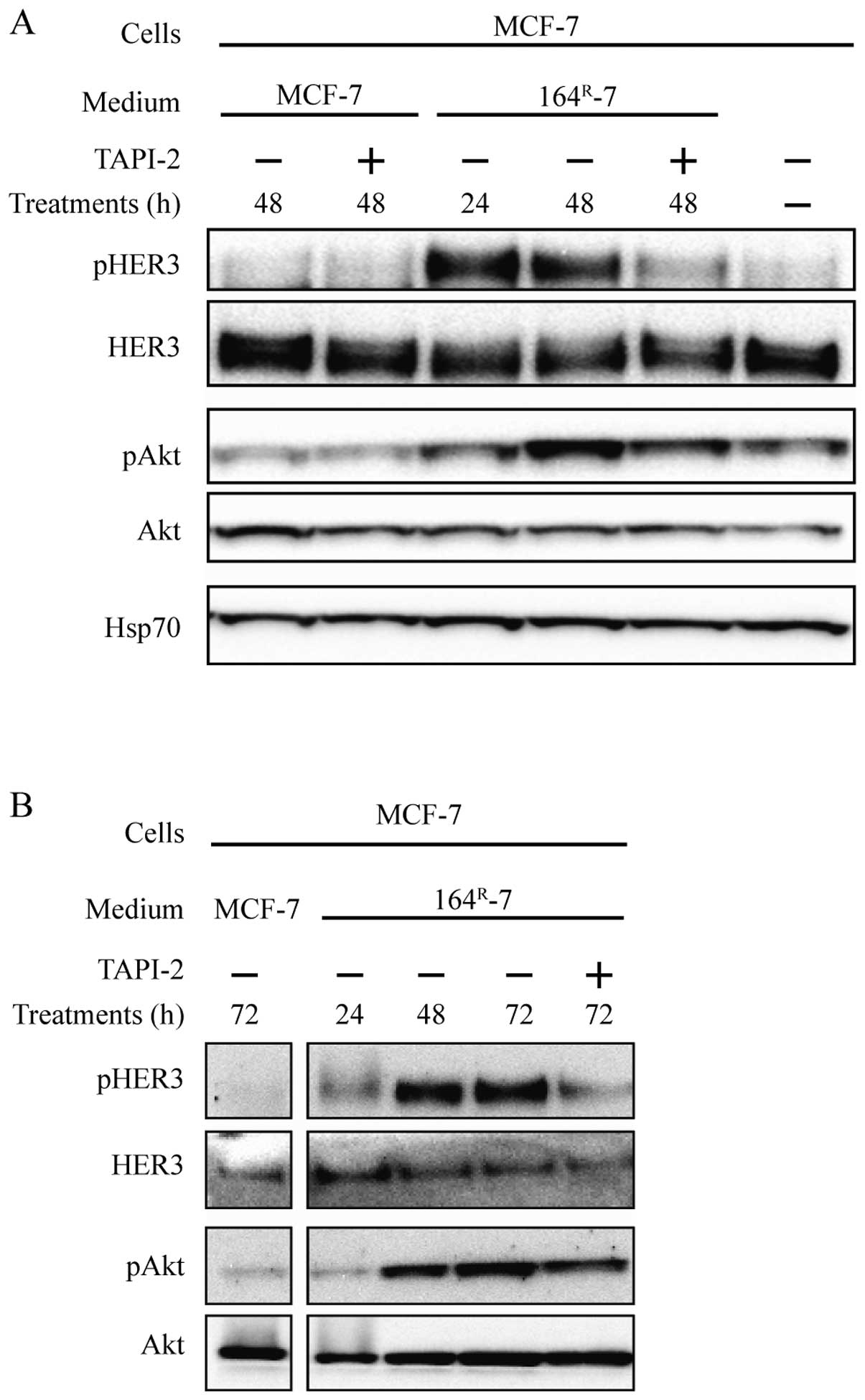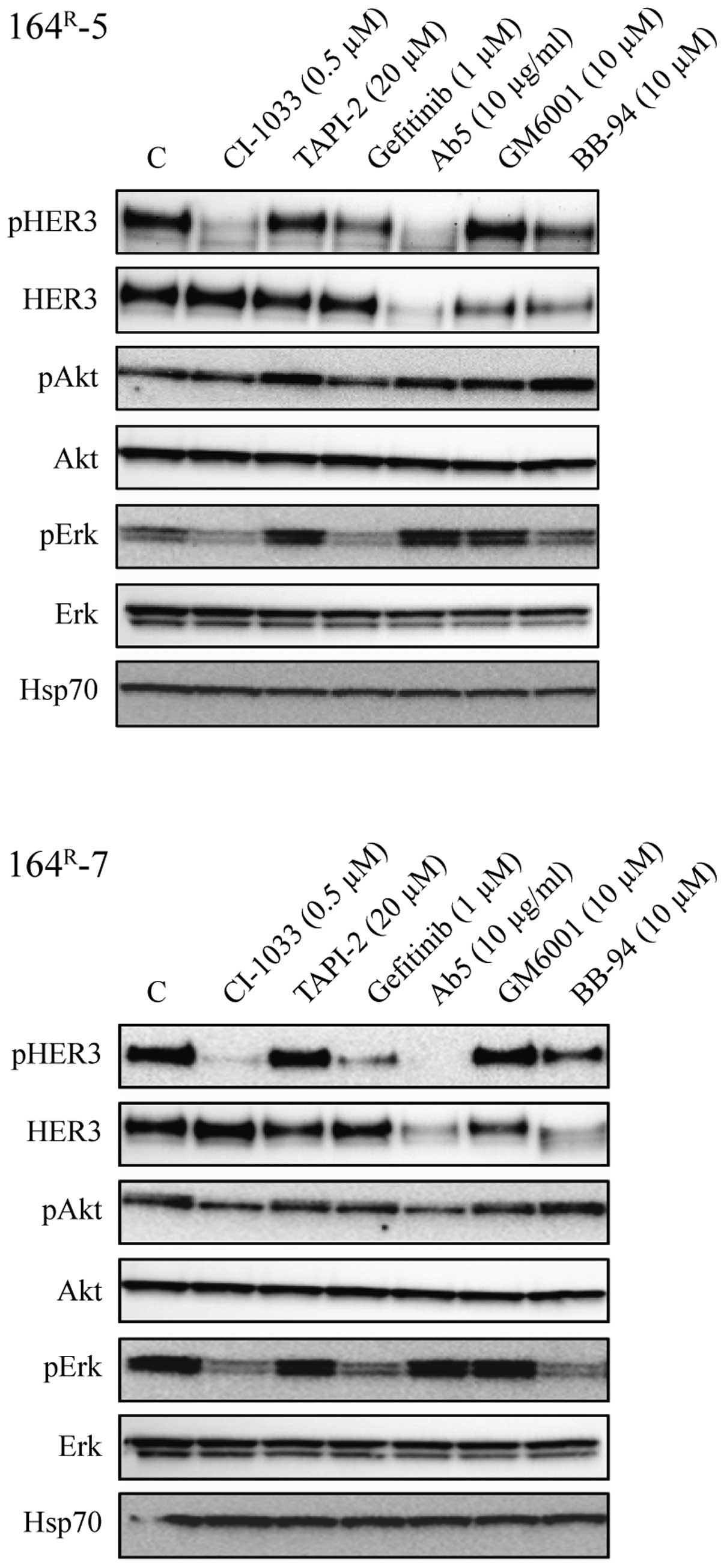|
1.
|
Valachis A, Mauri D, Polyzos NP, Mavroudis
D, Georgoulias V and Casazza G: Fulvestrant in the treatment of
advanced breast cancer: a systematic review and meta-analysis of
randomized controlled trials. Crit Rev Oncol Hematol. 73:220–227.
2010. View Article : Google Scholar : PubMed/NCBI
|
|
2.
|
Frogne T, Benjaminsen RV, Sonne-Hansen K,
et al: Activation of ErbB3, EGFR and Erk is essential for growth of
human breast cancer cell lines with acquired resistance to
fulvestrant. Breast Cancer Res Treat. 114:263–275. 2009. View Article : Google Scholar : PubMed/NCBI
|
|
3.
|
McClelland RA, Barrow D, Madden TA, et al:
Enhanced epidermal growth factor receptor signaling in MCF7 breast
cancer cells after long-term culture in the presence of the pure
antiestrogen ICI 182,780 (Faslodex). Endocrinology. 142:2776–2788.
2001.PubMed/NCBI
|
|
4.
|
Sommer A, Hoffmann J, Lichtner RB,
Schneider MR and Parczyk K: Studies on the development of
resistance to the pure antiestrogen Faslodex in three human breast
cancer cell lines. J Steroid Biochem Mol Biol. 85:33–47. 2003.
View Article : Google Scholar : PubMed/NCBI
|
|
5.
|
Massarweh S, Osborne CK, Creighton CJ, et
al: Tamoxifen resistance in breast tumors is driven by growth
factor receptor signaling with repression of classic estrogen
receptor genomic function. Cancer Res. 68:826–833. 2008. View Article : Google Scholar
|
|
6.
|
Sonne-Hansen K, Norrie IC, Emdal KB, et
al: Breast cancer cells can switch between estrogen receptor alpha
and ErbB signaling and combined treatment against both signaling
pathways postpones development of resistance. Breast Cancer Res
Treat. 121:601–613. 2010. View Article : Google Scholar
|
|
7.
|
Zahnow CA: ErbB receptors and their
ligands in the breast. Expert Rev Mol Med. 8:1–21. 2006. View Article : Google Scholar : PubMed/NCBI
|
|
8.
|
Gullick WJ: c-erbB-4/HER4: friend or foe?
J Pathol. 200:279–281. 2003. View Article : Google Scholar : PubMed/NCBI
|
|
9.
|
Yarden Y and Sliwkowski MX: Untangling the
ErbB signalling network. Nat Rev Mol Cell Biol. 2:127–137. 2001.
View Article : Google Scholar : PubMed/NCBI
|
|
10.
|
Witton CJ, Reeves JR, Going JJ, Cooke TG
and Bartlett JM: Expression of the HER1-4 family of receptor
tyrosine kinases in breast cancer. J Pathol. 200:290–297. 2003.
View Article : Google Scholar : PubMed/NCBI
|
|
11.
|
Tovey S, Dunne B, Witton CJ, Forsyth A,
Cooke TG and Bartlett JM: Can molecular markers predict when to
implement treatment with aromatase inhibitors in invasive breast
cancer? Clin Cancer Res. 11:4835–4842. 2005. View Article : Google Scholar : PubMed/NCBI
|
|
12.
|
Frogne T, Laenkholm AV, Lyng MB, Henriksen
KL and Lykkesfeldt AE: Determination of HER2 phosphorylation at
tyrosine 1221/1222 improves prediction of poor survival for breast
cancer patients with hormone receptor-positive tumors. Breast
Cancer Res. 11:R112009. View
Article : Google Scholar : PubMed/NCBI
|
|
13.
|
Blobel CP: ADAMs: key components in EGFR
signalling and development. Nat Rev Mol Cell Biol. 6:32–43. 2005.
View Article : Google Scholar : PubMed/NCBI
|
|
14.
|
Piccart-Gebhart MJ, Procter M,
Leyland-Jones B, et al: Trastuzumab after adjuvant chemotherapy in
HER2-positive breast cancer. N Engl J Med. 353:1659–1672. 2005.
View Article : Google Scholar : PubMed/NCBI
|
|
15.
|
Slamon DJ, Leyland-Jones B, Shak S, et al:
Use of chemotherapy plus a monoclonal antibody against HER2 for
metastatic breast cancer that overexpresses HER2. N Engl J Med.
344:783–792. 2001. View Article : Google Scholar : PubMed/NCBI
|
|
16.
|
Valabrega G, Montemurro F, Sarotto I, et
al: TGFalpha expression impairs Trastuzumab-induced HER2
downregulation. Oncogene. 24:3002–3010. 2005. View Article : Google Scholar : PubMed/NCBI
|
|
17.
|
Motoyama AB, Hynes NE and Lane HA: The
efficacy of ErbB receptor-targeted anticancer therapeutics is
influenced by the availability of epidermal growth factor-related
peptides. Cancer Res. 62:3151–8315. 2002.PubMed/NCBI
|
|
18.
|
Lykkesfeldt AE, Larsen SS and Briand P:
Human breast cancer cell lines resistant to pure anti-estrogens are
sensitive to tamoxifen treatment. Int J Cancer. 61:529–354. 1995.
View Article : Google Scholar : PubMed/NCBI
|
|
19.
|
Frogne T, Jepsen JS, Larsen SS, Fog CK,
Brockdorff BL and Lykkesfeldt AE: Antiestrogen-resistant human
breast cancer cells require activated protein kinase B/Akt for
growth. Endocr Relat Cancer. 12:599–614. 2005. View Article : Google Scholar : PubMed/NCBI
|
|
20.
|
Lundholt BK, Briand P and Lykkesfeldt AE:
Growth inhibition and growth stimulation by estradiol of estrogen
receptor transfected human breast epithelial cell lines involve
different pathways. Breast Cancer Res Treat. 67:199–214. 2001.
View Article : Google Scholar
|
|
21.
|
Pancholi S, Lykkesfeldt A, Hilmi C, et al:
ERBB2 influences the subcellular localization of the estrogen
receptor in tamoxifen-resistant MCF-7 cells leading to the
activation of AKT and p90RSK. Endocr Relat Cancer. 15:985–1002.
2008. View Article : Google Scholar : PubMed/NCBI
|
|
22.
|
Nicholson RI, Hutcheson IR, Harper ME, et
al: Modulation of epidermal growth factor receptor in
endocrine-resistant, oestrogen receptor-positive breast cancer.
Endocr Relat Cancer. 8:175–182. 2001. View Article : Google Scholar : PubMed/NCBI
|
|
23.
|
Rasmussen BB, Regan MM, Lykkesfeldt AE, et
al: Adjuvant letrozole versus tamoxifen according to
centrally-assessed ERBB2 status for postmenopausal women with
endocrine-responsive early breast cancer: supplementary results
from the BIG 1–98 randomised trial. Lancet Oncol. 9:23–28.
2008.
|
|
24.
|
Schwartzberg LS, Franco SX, Florance A,
O'Rourke L, Maltzman J and Johnston S: Lapatinib plus letrozole as
first-line therapy for HER-2+ hormone receptor-positive
metastatic breast cancer. Oncologist. 15:122–129. 2010. View Article : Google Scholar : PubMed/NCBI
|
|
25.
|
Larsen SS, Egeblad M, Jaattela M and
Lykkesfeldt AE: Acquired antiestrogen resistance in MCF-7 human
breast cancer sublines is not accomplished by altered expression of
receptors in the ErbB-family. Breast Cancer Res Treat. 58:41–56.
1999. View Article : Google Scholar : PubMed/NCBI
|
|
26.
|
Sahin U, Weskamp G, Kelly K, et al:
Distinct roles for ADAM10 and ADAM17 in ectodomain shedding of six
EGFR ligands. J Cell Biol. 164:769–779. 2004. View Article : Google Scholar : PubMed/NCBI
|














